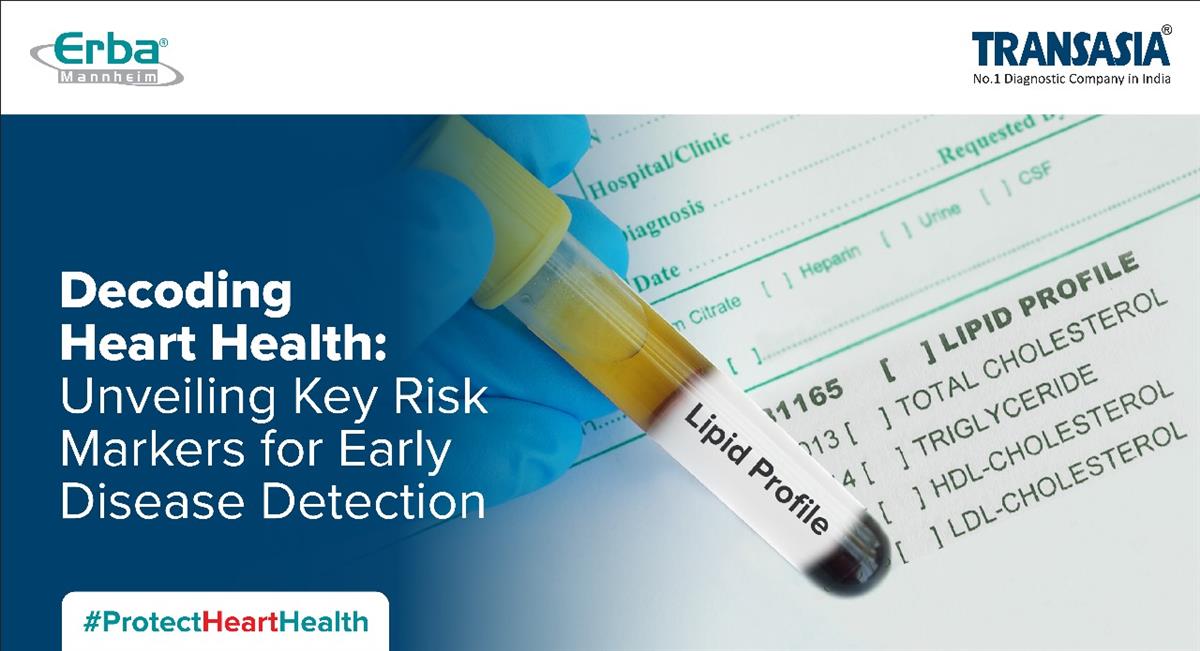
Decoding Heart Health: Unveiling Key Risk Markers for Early Disease Detection
Worldwide, 29th September is observed as World Heart Day each year. Brands all over the country come up with innovative ideas and run campaigns on social media to spread awareness about heart diseases.
While different types of information are available online and on social media for a healthy heart, as India’s #1 IVD Company, here’s what we would like to share and let you know what we are best at; providing effective screening solutions for an early diagnosis to prevent heart disease.
It’s all in the blood!
Without ignoring the importance of a healthy lifestyle, we would like to emphasize the importance of getting screened regularly, which includes simple diagnostic tests. Everyone’s well aware of the fact that as the most vital body fluid, blood is a powerhouse of information to know one’s state of physical well-being. Let’s deep dive and get to know some of the most important heart health indicators:
Diagnostic markers and their significance
Cholesterol
Known to almost everyone! When you can’t blame it on anything else, blame it on cholesterol. This steroid is essential to make hormones for development, growth, and reproduction, and the bile acids to absorb nutrients from food. A small amount of cholesterol circulates in the blood in complex particles, known as lipoproteins.
Depending on their density, lipoproteins are classified as follows:
- HDL – high density lipoprotein
- LDL – low density lipoprotein
- VLDL – very low density lipoprotein
HDL is the “good cholesterol”, and LDL is the “bad cholesterol” that gets deposited in the tissues. The ideal situation would be good enough levels of HDL and low levels of LDL cholesterol.
Cholesterol helps in screening the risk of developing heart disease or to monitor the effectiveness of lipid-lowering therapy. Your doctor would advise you to undergo a total cholesterol test to get a better insight into the HDL and LDL levels, as a part of the lipid profile.
Triglycerides
Triglycerides, a form of fat, are a major source of energy. Most triglycerides are found in the fat (adipose tissue). After eating, a large amount of triglycerides are found in the blood as the body converts energy into fat. These triglycerides are released back into the blood and used later as an energy source. High levels of triglycerides are associated with an increased risk of developing CVD, though the reason for it is unclear.
CK-MB
People brought into a hospital in an emergency situation with chest discomfort, are initially assessed for myocardial infarction (heart attack) through an ECG and blood test. Specific proteins such as CK-MB (Creatine Kinase-MB) are normally present within the heart cells and released into the blood post a heart attack, thereby indicating damage. However, CK-MB is not specific to the heart and is also found in other muscles, although in small amounts. Hence CK-MB is often advised as a follow-up to a CK test, which is more specific to muscle damage. Chest pain and increased CK levels with elevated CK-MB is an indication of a heart attack or a subsequent heart attack.
CK-NAC
Creatine Kinase is present in skeletal muscles, cardiac muscles, and in the brain. Estimating the level of creatine kinase is an essential diagnostic parameter while following myocardial infarction. CK activity begins to rise about 4-6 hours following myocardial infarction and peak values are attained after 24-30 hours and restore back to normal within 2-3 days. Elevated CK levels help to differentiate myocardial infarction from congestive heart failure and other conditions.
There are several other parameters, which help assess the health of your heart and help you stay informed. These include:
- Apolipoprotein A1 and Apolipoprotein B – These are proteins that combine with lipids to make lipoproteins. Apolipoprotein A1 is the main protein component in HDL and is tested if you have low levels of HDL. Likewise, Apolipoprotein B1 is the main component in LDL and indicates LDL levels. An increased ratio of ApoB to Apo A-I may indicate a higher risk of developing CVD. Lipoprotein (a) – A type of lipoprotein that carries LDL. The levels are measured to evaluate the risk of developing cardiovascular disease. Although considered to be a risk factor, the amount of Lp(a) is determined by the inherited genes and remains constant. It doesn’t respond to the treatment process like LDL does.
- Hs-CRP - CRP (C-reactive protein) levels increase in the blood with inflammation, infection, and following a heart attack. A high-sensitivity CRP test accurately detects low levels of CRP to identify low but persistent inflammation levels and thus helps predict a person's risk of developing CVD. Normal but slightly high levels of CRP in otherwise healthy individuals can predict the future risk of a heart attack even when cholesterol levels are within an acceptable range.
We are committed to a Healthier and Happier World!
Transasia Bio-Medicals Ltd. provides a wide range of highly sensitive and specific Erba reagents that help to detect, and monitor the severity of cardiac diseases and predict their future risk. These reagents are useful to test for cardiac markers, such as cholesterol, HDL, LDL, triglycerides, CK-MB, CK-NAC, Apo A1 and B, Lp(a) and Hs-CRP. These reagent kits are intended for processing blood samples on advanced semi as well as fully-automated Clinical Chemistry analyzers of the EM and XL series.
Join us in raising awareness by encouraging everyone to stay informed about their hearts and to #ProtectHeartHealth